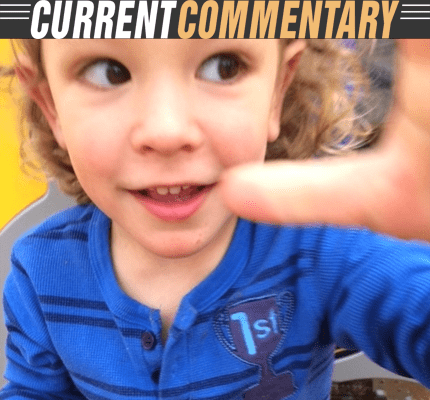
On Incommunicability and Autism
By Miranda J. Brady, Ph.D.
“The question should be not can we communicate with each other? But can we love one another and treat each other with justice and mercy?” (John Durham Peters, Speaking into the Air, 1999, pg. 268).
I am at the park with my 3-year-old son on a warm summer day. He stands in front of a swing, yanking it back and forth as he gazes up, mesmerized by the movement of the metal chain supporting the seat from above. Every now and then, he laughs and begins stimming, jumping up and down with excitement, pacing. Then it all starts over again. Parents and children look over, a little confused at this “misuse” of the swing, especially as they are waiting to use it. A friend of my son’s from daycare approaches and says enthusiastically, “Hi Ewan!” My son neither acknowledges her nor pauses what he is doing. She isn’t fazed; she is used to this lack of response. I say hi and chat with the girl’s mother. Eventually, after several verbal prompts and an unsuccessful bribe, I say goodbye, scooping a kicking and screaming Ewan into my arms so that other children can have a turn with the swing. Parents continue to stare. One woman says good naturedly, “Someone needs a nap, huh?” She must be new. We visit the exact same spot daily, sometimes multiple times, to engage in the exact same set of actions over and over. Instead of explaining that my son is autistic and gets stuck in repetitious loops, I smile and say, “Yes, he’s pretty tired.” I employ this speech act as a means of situating my son’s behaviors within the discursive confines of a neurotypical world. But, there is so much that is lost in translation.

There are several normative modes of communication that the average person takes for granted, verbal speech being at the forefront. My son cannot communicate in this way, and this is typically seen as a deficit of his, rather than as a lack of understanding by neurotypicals. The failure to recognize neurological difference follows a long history of invisibility and marginalization of disabled persons and is therefore not surprising (Ginsburg & Rapp, 2015). There is also a lack of reflexivity related to the ideals of communication espoused by neurotypicals.
First, more communication is not necessarily better; a case in point is the ongoing exchange of insults by world leaders via social media, which threaten to incite a nuclear catastrophe. As with this instance, neurotypicals often employ communication to do violence to others. So, why do we cling desperately to the idea that communication is a good in and of itself? Moreover, why do we treat particular modes of communication as though they are the panacea for all social problems?
Dialogic communication is likely the most privileged. As John Durham Peters (1999) discusses, people often think of dialogue as inherently democratic and inclusive. In his seminal history of the idea of communication, Peters questions the long-held delusion that souls can unite through perfect communication, where people are seamlessly understood and able to understand one another. Aside from the practicality that, “We can trade words but cannot share our existence,” dialogue clearly places some at a disadvantage, particularly those who, like my son, cannot speak (pg. 268).
The broader point for Peters is that it is not a lack of understanding but our failure to agree that creates conflict. As Peters suggests, “dialogue may simply be two people taking turns broadcasting at each other” (pg. 264). This is not a failure of communication as such, he posits. More communication will not necessarily promote enlarged thinking.
However, despite the impoverishment of communication ideals, the stakes are very high in not communicating to neurotypicals in a language and mode they understand. In her 2007 YouTube video, Autism Spectrum Disorder activist Amanda Baggs made this point. “I smell things,” “I feel things,” “I taste things,” Baggs asserts. For Baggs, interactions with her environment constitute an essential “language,” even when her interactions have no symbolic meaning attached. But, she explains, in order to be considered a thinking person and a legitimate human with rights, she has been forced to learn the language of neurotypicals and articulate her thoughts using computer assistive technologies. “It is only when I type something in your language that I am referred to as having communication” (Baggs, 2007). As with so many things, the burden of proof rests with the marginalized.
Baggs and other non-verbal autistics have worked hard to convince neurotypicals that people like them are capable of complex thinking. Importantly, they have also advocated on behalf of people with disabilities of all kinds, insisting on the value and power that difference can have in contributing to a strong social fabric. This kind of advocacy leads to serious material and political implications and should never be taken for granted. As Michael Berube (2003) writes of his Down Syndrome son, “…Jamie’s rights were invented, and implemented slowly and with great difficulty. The recognition of his human dignity, enshrined in these rights, was invented. And by the same token, those rights, and that recognition, can be taken away” (para. 12). Historic precedents have demonstrated the reality of this threat.
In his chilling account of the persecution of disabled persons during the Nazi regime, Steve Silberman (2015) traces the more extreme stakes in failures to recognize atypical minds as human. Under the Nazis, children with cognitive disabilities (like my son), were deemed to possess “life unworthy of life” and were routinely executed.
In the wake of this horrific treatment of people deemed less than human, the United Nations Universal Declaration of Human Rights (1948) emerged. However, despite this important insistence on the value of all human life, it was still common to institutionalize people with cognitive disabilities until the 1970s. It was only after this point that it became more common for parents to keep children with neurological differences at home. As Faye Ginsburg and Rayna Rapp (2015) point out, the symbolic annihilation though literal removal of people with disabilities from social spaces likely contributed to the failure of neurotypicals to understand alternative ways of thinking and being in the world.
There is no doubt that a shift is now happening. Although deinstitutionalization has facilitated an unreasonable burden for parents now faced with all of the bureaucratic, emotional, and financial responsibilities of care (Nadesan, 2013), and may sometimes alienate individuals living on their own, this shift has led to more nurturing, supportive environments and visibility for many people. But, neurotypicals still have a long way to go in changing their assumptions about what counts as legitimate interactions in the world.
I will never see the universe the way that my son does. We connect with each other, have disagreements, and express affection in some of the ways that neurotypicals do. Then again, there is so much unsaid that may never be communicated.
Perhaps in some senses, “Of all things, communication is the most wonderful” (Carey, 1989, pg. 13 citing John Dewey). However, one of its other major functions is to alienate. When I hear celebratory exaltations of the virtues of communication, I wonder what examples we conveniently forget. Rather than longing for better communication, I prefer to focus on my son joyously jumping up and down for no reason that is obvious to or intended for me.
References
- Baggs, Amanda. (2007). In My Language. Accessed through YouTube 29 October 2017 at: https://www.youtube.com/watch?v=JnylM1hI2jc
- Berube, Michael. (2003). Disability and Citizenship. Dissent: http://www.alternet.org/story/15809/citizenship_and_disability
- Carey, James. (1989). A Cultural Approach to Communication. In Communication as Culture: Essays on Media and Society. New York: Routledge.
- Ginsburg, Faye and Rapp, Rayna. (2016). Screening Disabilities: Visual Fields, Public Culture, and the Atypical Mind in the Twenty-First Century. Linker, Beth and Hirschmann, Nancy J. (eds). Civil Disabilities: Citizenship, Membership, and Belonging. Philadelphia: University of Pennsylvania Press, 103-122.
- Nadesan, Majia Holmer. (2013). Autism: Profit, Risk, and Bare Life. In Joyce Davidson & Michael Orsini (eds.), Worlds of Autism: Across the Spectrum of Neurological Difference. Minneapolis: University of Minnesota Press.
- Peters, John Durham. (1999). Speaking into the Air: A History of the Idea of Communication. Chicago: The University of Chicago Press.
- Silberman, Steve. (2015). Neuro Tribes: The Legacy of Autism and the Future of Neurodiversity. New York: Penguin Random House.
Photo of Ewan by Sandy Russill
A special thanks to the students in my Fall 2017 MA seminar at Carleton University, Foundations of Communication Studies.


